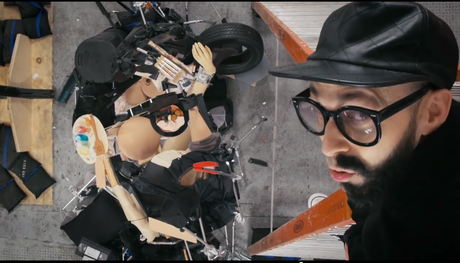By Siu-Lan Tan
When I saw OK Go’s ‘The Writing’s on the Wall’ video a few days ago, I was stunned. If you aren’t one of the over eight million people that has seen this viral music video yet, you’re in for a visual treat.
OK Go is known for creative videos, but this is the band’s richest musical collage of optical illusions so far. The most amazing part is that it was done … in one take!
Click here to view the embedded video.
Over 7.5 million viewers saw this extraordinary video in the first week it was posted.
And just newly released, OK Go uploaded this equally splendid video that gives us a ‘Behind-the-Scenes’ look.
Click here to view the embedded video.
Just a lucky coincidence?
OK Go posted ‘The Writing’s on the Wall’ on 17 June 2014. I wonder if they knew this is a significant date for Gestalt psychology? Important enough to be in the APA’s historical database for 17 June:
“June 17, 1924. Robert M. Ogden of Cornell University wrote to German psychologist Kurt Koffka, inviting him to become a visiting lecturer. This was the first step… that brought Gestaltists Koffka, Köhler, Wertheimer, and Lewin to America” (Street, 2007)
Wertheimer, Koffka, and Köhler are key figures in Gestalt psychology who laid the groundwork for what we know about perception, especially how we organize visual elements into meaningful wholes. Central to their work is the idea of ‘figure’ versus ‘ground’ – or how we distinguish the main focus (or figure) from the background or landscape in which it is set (ground).
They were also interested in perceptual illusions, influenced by psychologist Edgar Rubin who created many figure/ground illusions such as the Rubin vase, which now appears in every introductory psychology book.
Here’s a modern version: Are these columns or five tall standing figures with bowed heads? That depends on what you take to be figure vs. ground.

OK Go’s ‘The Writing on the Wall’ plays with figure/ground relations. Many illusions in this brilliant music video ambiguate, and then disambiguate, what is foreground versus background.
This is especially well illustrated in the illusion that “the writing’s on the wall” — as it never really is. In every appearance of the written word == in the title, the blurbs in the middle, and the amazing reveal at the end — the writing’s never on the wall.
Instead, the words blend figure and ground into single alignment. The illusion works — and then is dismantled before our eyes — as the movement of objects or camera disentangle what is foreground and background.
Figure and ground seem to dissolve into each other as the musicians emerge from the red, blue, yellow shapes.
Ambiguity of where figure and ground separate is pushed even further with single images that blend foreground with distant surfaces (floors, walls): blue spots, a network of cubes, a ladder, green checkered tiles, and a row of people that appear to stand together. It’s brilliantly captured at 02:47, in the aerial image of a multi-layered apparatus that “flattens out” into a representation of drummer Tim Nordwind’s bearded face (screenshot below).

The walkthrough also takes us through the development of art: from basic shapes, to patterns (dots, stripes), to 3D (or not) cubes, geometric sculptures, and finally to representations of the human face and full body figures.
The music is not just an accompaniment to the collage of optical illusions and paradoxes, but an integral part of the work. The song is about miscommunication that can go on in a relationship. (Or is the idea of two people really ‘getting each other’ merely an illusion?)
The result is wonderfully perplexing, a delicious trick of the senses. And a fitting tribute to the 17 June landmark in Gestalt psychology.
Siu-Lan Tan is Associate Professor of Psychology at Kalamazoo College in Michigan, USA. She is primary editor of The Psychology of Music in Multimedia (Oxford University Press 2013), the first book consolidating the research on the role of music in film, television, video games, and computers. A version of this article also appears on Psychology Today. Siu-Lan Tan also has her own blog, What Shapes Film? Read her previous blog posts.
Subscribe to the OUPblog via email or RSS.
Subscribe to only psychology articles on the OUPblog via email or RSS.
Image Credit: Optical illusion. Image by Sha Sha Chu. CC BY-NC-SA 2.0 via shashachu Flickr.
The post OK Go: Is the Writing on the Wall? appeared first on OUPblog.

By Siu-Lan Tan
Sometimes you think you can explain something, and then it turns out you really can’t. This remarkable video was posted last year but only went viral in the US in the last few weeks, approaching 5 million hits in a short time. When I first saw it, I was immediately enchanted.
Click here to view the embedded video.
Dubbed by the press as ‘the Mini Maestro’ (although to be correct, she would be a maestra), the video shows little Lara Glozou with a church choir in Kyrgyzstan. She’s the young daughter of one of the choir members and often attends rehearsal.
After watching a few times, I thought I knew what might be happening. This must be an observant child who’s mirroring the actions of a conductor standing in front of the choir, interspersed with a little improvisation of her own. I thought she was a remarkable imitator, not just able to capture the conductor’s motions, but also the emotions.
But then I found another video. It shows the choir rehearsing the same song from another angle, allowing us to see the conductor’s motions of the right hand while Lara is gesturing expressively in the far right corner by the piano.
Click here to view the embedded video.
I was amazed to see that the conductor is not making the same kinds of motions as Lara after all. Even though the conductor’s gestures may be outlining the regularity of the beat and phrasing, many of Lara’s gestures and body movements—the forward lean, the hand to the chest, the sway of the body, and the dips and turns of the head—seem to be her own.
To be fair, Lara is not really “conducting.” If she were directing, her motions would come slightly before the events in the music, in anticipation of them in order to cue the choir. Her movements are more like an expression of the music. However, as an expression or sensitive interpretation of the music, I find her gestures to be remarkable. Truly extraordinary. For instance, her gestures are fewer and more prolonged during the female solo up to 0:21 (on the first video). They are a series of poses. But at 0:22 when the choir comes in, she immediately shifts to grand sweeping gestures. The variety of shapes that she forms with her hands alone express a rainbow of emotions and tone colors.
I am in awe of this little girl’s ability not only to reflect peaks and valleys in the melody of the music, and momentum of the phrases, but also the shape of the sound. For the last note of the song, she curves her left and right hands into the widest arcs for a broad final tone — a lion’s roar — rather than the kind of ending that gradually fades away.
This small child has had so little time on earth to experience falling in love, the sting of heartbreak, betrayal, triumph, grief, pain, and the rest of the great emotional topography of life. How is she able to convey the semblance of emotional depth and angst? Where is she getting her musical sensitivity? Do some young children just have an old soul?
As a former music major, I took Conducting 101. My spine was rigid, my gestures were tiny and angular. As a music student in my 20s, I had none of the intensity and theatrical weight of this little girl. More recently, I have written about how infants begin to spontaneously respond to music in bodily ways, nodding their heads and waving arms to rhythmic music once they are able to sit freely at about six months. Later, bobbing up and down with knee-bends, and spinning around in circles to music between one and two years, after they become mobile.
However, they do so for only short bursts, and most of the movements of two- and three-year-old children don’t really match the music in time (Moog, 1976; Malbrán, 2000). Although Lara is not always synchronized with the music, her deep expressive gestures capture the musical events in a broad way, even anticipating some musical moments, as she is familiar with this piece.
Little is known about young children’s interpretation of music. In one of the few studies in this area, Boone & Cunningham (2001) showed that four-year-olds can move a flexible teddy bear in dance-like fashion, to express emotion in music through movement. However the musical emotions they recognized and expressed were basic emotions (such as happiness, or sadness, or anger). What we seem to observe in Lara is much more nuanced. How is she able to capture this depth in music?
I spoke with a grown-up maestro that I greatly admire, Andrew Koehler, Music Director of the Kalamazoo Philharmonia. He said, “It’s really astonishing. Lara moves in a way that shows that she recognizes agogic accents“ (longer durations of tones, which give natural stress to music). She often reflects this with larger, more expansive motions of her arms that mark those accents.
Her gestures also capture finer details. At 0:45 to 0:47 in the first video, Koehler points out how a higher tone of greater tension resolves to a lower tone of lower tension. The toddler reflects this: “Lara leans into the music, her right hand pushing into it with a claw-like motion [capturing high tone and high tension in the music]. Then both left and right arms make downward motions as her posture goes back to an upright position again [lower tone, lower tension].”
And then there’s Jonathan Okseniuk. Here he is at three years old, appearing to ‘conduct’ a recording of the last movement of Beethoven’s Fifth Symphony in his home in Mesa, Arizona.
Click here to view the embedded video.
Even if he appears to be getting some coaxing off camera, this is a remarkable three-year-old.
Here is Jonathan again at age four, conducting a live orchestra in a rousing rendition of Khachaturian’s ‘Sabre Dance’. “This is a more challenging arena,” explains Koehler, “which would require Jonathan to anticipate what will happen in the music as opposed to simply responding to it.”
Click here to view the embedded video.
There are many other videos of Jonathan on the web, conducting Beethoven, Brahms, Mozart, and Strauss with different orchestras.
How an understanding of music blooms so early in some young ones astonishes me. This mini-maestra’s sensitive expression of music and mini-maestro’s early conducting chops have left me perplexed.
Siu-Lan Tan is Associate Professor of Psychology at Kalamazoo College in Michigan, USA. She is primary editor of The Psychology of Music in Multimedia (Oxford University Press 2013), the first book consolidating the research on the role of music in film, television, video games, and computers. A version of this article also appears on Psychology Today. Siu-Lan Tan also has her own blog, What Shapes Film? Read her previous blog posts.
Subscribe to the OUPblog via email or RSS.
Subscribe to only psychology articles on the OUPblog via email or RSS.
The post Mini maestro mystifies me appeared first on OUPblog.





